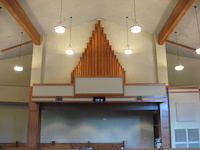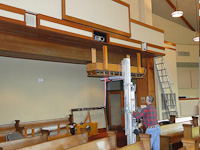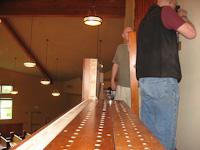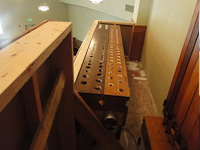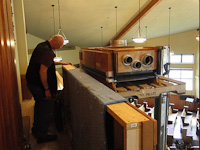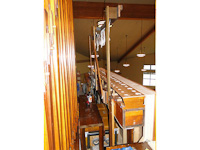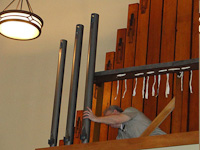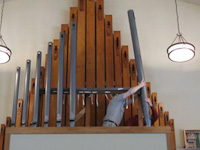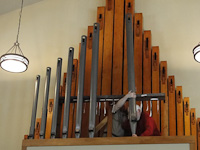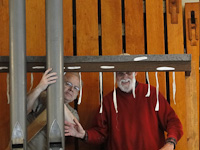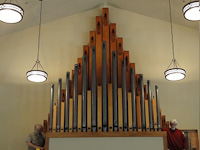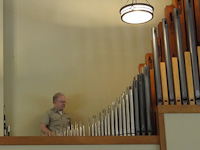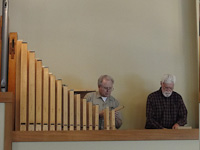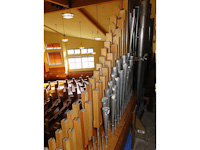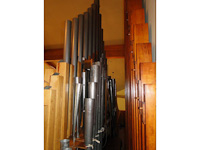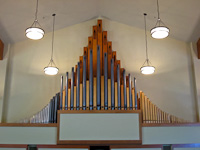Covenant Presbyterian Antiphonal Organ Installed
Carl Dodrill 06/29/11
In a previous News article dated 3-23-11, the first part of the installation of the Antiphonal organ was covered. At that time, details and photos were included on how the 16' Violone was installed on the back wall of the sanctuary. The ledge on which this installation took place is 27 feet wide but only about 3 feet deep, and the ledge is 13 feet off the sanctuary floor. The Antiphonal organ consists of four ranks of pipes representing all of the four types of pipes found in pipe organs: 1) Principal --8' Violin Diapason playable at 8' and at 4'; 2) Flute -- Melodia playable at 8', 4', 2 2/3', and 2'' 3) String --Violone playable at 16', 8', and 4'; and, 4) Reed -- Cornopean playable at 8' and 4'. As can be seen, not only are a variety of sounds represented in this Antiphonal organ, but a range of pitches is also included. This arrangement was found to be very successful in one our prior organ placements at Mercer Island Presbyterian Church, and it was therefore utilized here.
Since the installation of the Violone pipes in March, Jim R. and his crew at the church have worked on preparing the skirting which goes around the edge of the Antiphonal area, and this is shown in the first photo. This was the situation found by our volunteer crew when it arrived on April 23 to begin the two day installation of the Antiphonal organ. The blower had already been put into the room back of the Violone pipes by the crew at the church, and the category 5 control line from the console had already been pulled through to the Antiphonal area as well.
The Foundation crew rented a hand crank fork lift, and all but the pipes were raised up on that lift. The second, third, and fourth photos show the lifting of the first windchest, and the fifth photo shows its placement up against the skirting at the east end of the ledge. In order to save space, care was taken to put the legs of each chest inside the wall of the skirting so that not a single inch was lost. Every effort was also made to protect the organ against earthquake by cleating the windchests to the floor and by connecting them to the skirting.
After the windchests holding the 4' and smaller pipes were put at the far east and far west ends of the ledge, the regulator was brought up as was the center windchest and the walkboard. The walkboard spans the regulator and sits between the 16' Violone pipes and the center windchest with its racking. As can be seen in Photo 8, the situation is tight, but with every effort made to provide space for service in the future.
Beginning the second day of the installation, the pipes were brought up. We began with the Violin Diapason rank and installed it across the front of the center windchest. The installation of the larger pipes was somewhat tricky due to their length. It was found to be best to march them along the top of the windchest in a vertical position but outside the racking. Just below was the 17 foot drop-off to the sanctuary floor. The photos show how this installation was done. The 8' octave of the Melodia was next put in place. The interspersing of these two ranks is unusual, but it was necessary due to the greatly limited space available.
The photos show how the 4' and shorter pipes are placed in the windchests on the far western and far eastern ends of the deck. Particular care was taken to hide the Cornopeans as they are less appealing visually. In order to hide the longer Cornopeans, the technique of conveyed wind was used with the toes of the pipes almost on the floor of the deck.
The final product of the two day installation is shown in the last photo. After these two days of intensive work, the crews from the Foundation and the church returned to install the electrical cables, the signal cable from the console, and the blower. Organist Jim W. played it for the first time in worship service on 06/19/11 and most of the congregation stayed to hear the memorable postlude which was the Toccata from Widor's Fifth Symphony. Final tonal work was then undertaken by Frans Bosman and Rene Marceau and the very last adjustments are being made at the time of this writing. It is expected that this Antiphonal organ will make a major contribution to this instrument for many years to come.
See the photos in the left sidebar and click on the small images to enlarge.
(Photo credits to Carl P., Bob B., and Carl D.)

